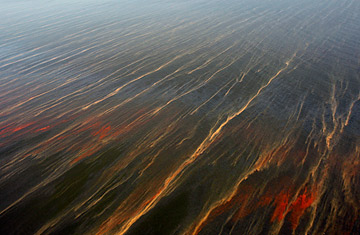
Oil streaks across the Gulf of Mexico after the collapse of the Deepwater Horizon oil rig
As BP's efforts to stanch the flow of oil gushing out of its collapsed rig in the Gulf of Mexico continue, there's not much for any of the world's giant petroleum companies to feel good about, but Exxon, at least, has one tiny reason to smile. As of today, its name will no longer be linked to the words nation's worst oil spill. After 21 years, the notorious Exxon Valdez disaster has dropped to second place on that ignoble list, replaced by BP's Deepwater Horizon.
The news was shocking — not just because nobody wanted to think that such a disaster would ever be repeated, much less exceeded, but because of how dramatically the new spill has outdistanced the old one. The Exxon Valdez tanker dumped 11 million gal. of oil into Alaska's sensitive waters. BP may have more than tripled that figure, with a stomach-turning 39 million. The rate of spill could be as high as 25,000 bbl. per day, or five times BP's sunnier estimate of 5,000.
It took a long time to get the new estimates, in part because the U.S. Geological Survey (USGS), which released the figures on Thursday, worked with a lot of partners — including the National Oceanic and Atmospheric Administration, the National Institute of Standards and Technology and experts from nine universities. The teams also used three different measuring techniques to arrive at their numbers.
The first method relied on NASA's Airborne Visible Infrared Imaging Spectrometer (AVIRIS) a system that, as its name suggests, relies on infrared reflections to do its work and, as its name is too modest to mention, has also been used to detect water on the moon. In recent days, an airplane equipped with an AVIRIS system has made repeated passes over the Gulf, scanning the surface of the water for the signature reflection of oil and recording what it finds. The technique is not perfect, since the plane can cover only a relatively small patch of the Gulf in a day and analysts must proceed on the assumption that the oil it finds in one area is representative of others. Still, repeated passes over numerous spots led to the estimate that between 130,000 and 270,000 bbl. of oil are floating on the surface. The analysts also estimated that a similar amount has already been skimmed, burned or evaporated off the water. The AVIRIS team's final estimate was that the overall flow rate is from 12,000 to 19,000 bbl. per day.
The second technique looks beneath the surface, observing the plumes rising from the end of the broken riser pipe and from the smaller fractures along its kinked and cracked stretches. Using video analyses of the velocity and volume of the fluid, the team arrived at a somewhat cruder estimate of 12,000 to 25,000 bbl. per day. The live feeds from a mile down that have been all over the Internet and cable news for the past several days illustrate the shortcomings inherent in this method — principally the problems of poor lighting, limited angles and obstructed views.
The final measurement method relied on an instrument attached to the mile-long tube that engineers inserted into the broken riser pipe to collect a portion of the escaping oil. The device found that 10% of the oil pouring from the end of the pipe was not being collected — which sounds like good news since it should mean that 90% was. But even that escaping fraction raised the USGS's estimated flow rate to 8,800 bbl. per day. The additional amount escaping from the cracks in the pipe boosted it to 11,000.
The USGS, President Obama and no end of federal officials have repeatedly stressed that in some respects, the precise flow rate is academic, since the effort to cap the well and protect the Gulf would proceed the same way no matter what. But the fact that even the lowest estimates are more than double BP's points to the importance of having an uninterested party like the government check the oil company's math. The fact that the highest estimates quintuple BP's figures point to the extent of the environmental disaster still unfolding — and the terrible cleanup job that lays ahead.
